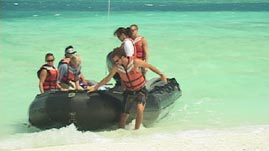Teachers' Domain - Digital Media for the Classroom and Professional Development
User: Preview

Source: The Bishop Museum, Honolulu, Hawaii
This video segment adapted from the NOW-RAMP 2002 Expedition follows a team of U.S. Fish and Wildlife researchers as they visit the northwest tip of the Hawaiian Islands to document wildlife populations and help control invasive species. The Pearl and Hermes Atoll, one of the oldest landmasses in the Hawaiian Island chain, supports an impressive diversity of plants and animals but, like many islands, is vulnerable to invasive species.
Speciation is the process by which new species evolve. Many islands provide a perfect set of circumstances to set this process in motion. Hypothetically, a small number of birds or turtles or beetles happen onto the shores of a newly formed island that provides unexploited opportunities and novel selective pressures. Isolated from their parent population, these founders and their offspring are free to explore new environments and opportunities. Those that do well survive long enough to reproduce and pass on their genes.
Often, speciation results in a new species, which, to the untrained eye, is little changed from the parent species. Perhaps the island species has a slightly longer neck or a unique song. In some cases, however, new opportunities or an absence of pressures in the newfound land result in behaviors or body plans that would be out of place anywhere else. Giant tortoises, flightless birds, and animals without fear of potential predators are just a few examples of the many evolutionary wonders found on islands.
This much is clear: if the isolation that helped them evolve in the first place is suddenly compromised, many island species will be vulnerable. Species that have evolved without predators—those who may lack an innate fear of other animals or are unable to avoid them—are particularly vulnerable to invasive species from the mainland, such as rats, pigs, and domestic cats. Species endemic to islands have been plagued, and in many cases driven to extinction, by animals introduced by humans, either intentionally or accidentally. Plants, too, can invade an ecosystem, often quietly wreaking as much or more ecological havoc than animal invaders. Typically, such plant species simply out-compete their native rivals for resources such as water and nutrients. They may also be less vulnerable to herbivores if the invasive species is particularly unpalatable.
Although invasive species on islands provide some of the most striking examples of damage on record, there are plenty of invaders on the mainland as well. Again, initial isolation plays an important role. Often invasive species arrive from other continents and find new opportunities or decreased pressure in a new ecosystem. A weed called leafy spurge, for example, is taking over ranchland in the western United States because the beetle that eats and keeps leafy spurge in check in its native environment (Europe and Asia) is absent from North America.
If such invasions were a natural occurrence, they would still be troubling from a species conservation perspective, but they might be more acceptable. However, in nearly all instances, invasive species have relied on humans to transport them to new lands. Consequently, we have a dual responsibility: to do our best to mitigate the invaders' effects and to prevent similar invasions in the future.
 Loading Standards
Loading Standards Teachers' Domain is proud to be a Pathways portal to the National Science Digital Library.
Teachers' Domain is proud to be a Pathways portal to the National Science Digital Library.
